Pritzker ‘fair tax’ would cost typical Illinois family $3,500, cost state economy 286,000 jobs
By Orphe Divounguy, Bryce Hill
Pritzker ‘fair tax’ would cost typical Illinois family $3,500, cost state economy 286,000 jobs
By Orphe Divounguy, Bryce Hill
Illinois Gov. J.B. Pritzker has proposed a “fair tax” plan he claims would cut taxes for 97 percent of Illinoisans.
But his proposed tax rates would raise only $1.4 billion, less than half of the $3.4 billion the governor has projected the tax hike would bring in, or the $3.3 billion required to close the current structural deficit. And even Pritzker’s revenue overestimate is far short of the $14 billion to $19 billion required to meet the governor’s spending promises.
If Pritzker is serious about his proposed spending, these initial tax rates would have to be increased across the board, with the typical middle-income family seeing a tax hike of up to $3,500.
Pritzker called his first budget proposal a “bridge” budget, claiming it was “austere” compared with the spending he would like to propose.1 Pritzker confirmed his spending priorities from the campaign trail by proposing new spending for education, social services and public safety.2 According to Pritzker’s budget speech and accompanying budget documents, he won’t be able to spend as much as he would like to without revenue from a progressive income tax hike.3
Raising enough revenue to meet the governor’s spending priorities while maintaining the same level of progressivity as his proposed rate schedule would require higher rates for everyone. (See Appendix A for a detailed cost estimate of Pritzker’s spending proposals.)
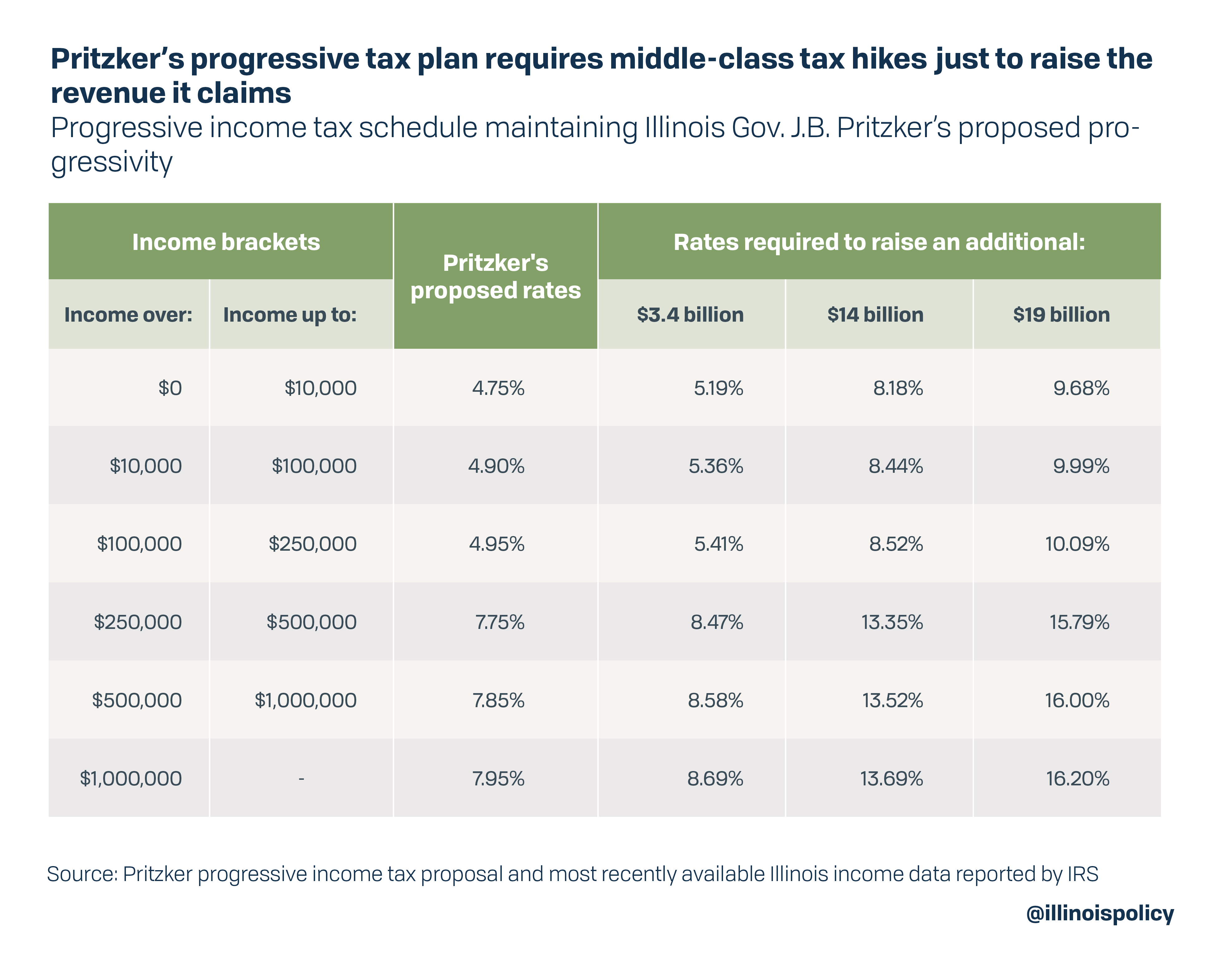
Even after accounting for other sources of new revenue from tax and fee hikes in his fiscal year 2020 proposed budget, Pritzker would need to raise between $14.3 billion and $19.4 billion4 from a progressive tax hike to fully implement his promised spending in fiscal year 2022: the first full fiscal year for which a progressive income tax could generate revenue.5
Under the tax rates necessary to raise this amount of revenue, the typical Illinois family would pay between $2,425 and $3,508 more in income taxes. Even closing the structural deficit with a progressive tax hike similar to what Pritzker proposed would require hiking taxes on the average middle class family by nearly $270.
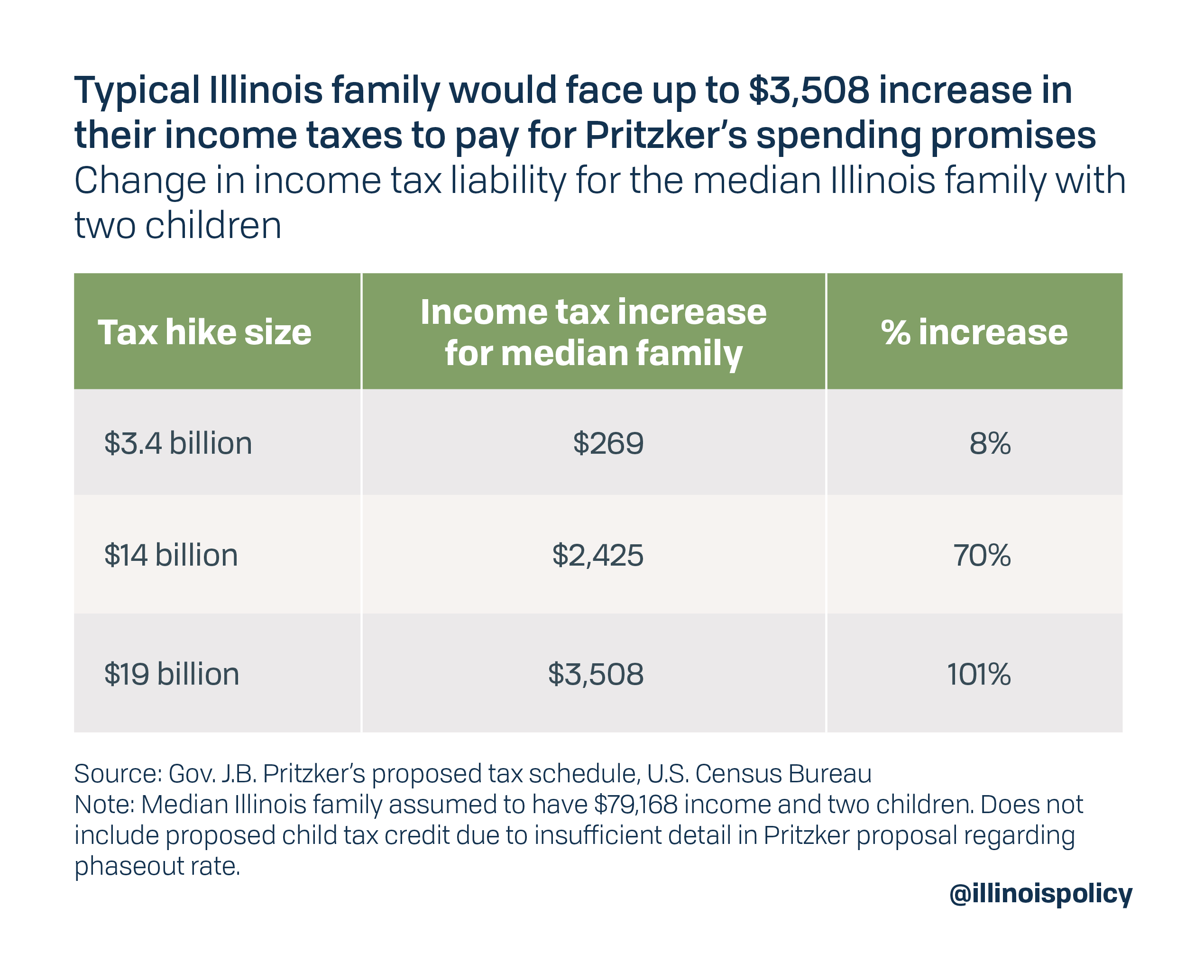
Even if Pritzker were to fall short of the full spending promises made during his campaign, the governor has made clear he wants to significantly increase spending beyond what current fiscal constraints allow on all levels of education, various social services and infrastructure. Billions of dollars of additional spending cannot be financed with the tax rates currently proposed by Pritzker’s administration. And his proposed constitutional amendment would give middle-class taxpayers no guarantees that these tax rates would be adopted, much less that they would stay at the same levels in the future.
In short, to the extent that Pritzker’s first budget proposal is a “bridge,” it is likely to be a bridge to future middle-class tax hikes.
This resembles what happened in the last state to switch to a progressive income tax, Connecticut. Initial tax hikes led to persistent budget shortfalls, so in an effort to raise more revenue, Connecticut hiked income tax rates on the average middle-income earner by 13 percent.
Not only would a progressive income tax hike end up taking more money directly from all taxpayers’ pockets, but it would also have negative economic effects on jobs growth, after-tax income adjusted for cost of living, and overall economic output.
Economic effects of the progressive tax hike
The massive tax hikes resulting from a progressive income tax to fund Pritzker’s spending promises would wreak havoc on Illinois’ fragile economy. Economic modeling shows a tax hike of this size could eventually cost the state between $33.3 billion and $43.2 billion in forgone economic activity. (See Appendix B for full methodology.)

Not only would the tax hike inflict billions of dollars’ worth of economic damage, but it would cost the state thousands of jobs. Paying for Pritzker’s spending promises through his preferred progressive income tax could eventually cost Illinois between 208,000 and 286,000 forgone jobs.
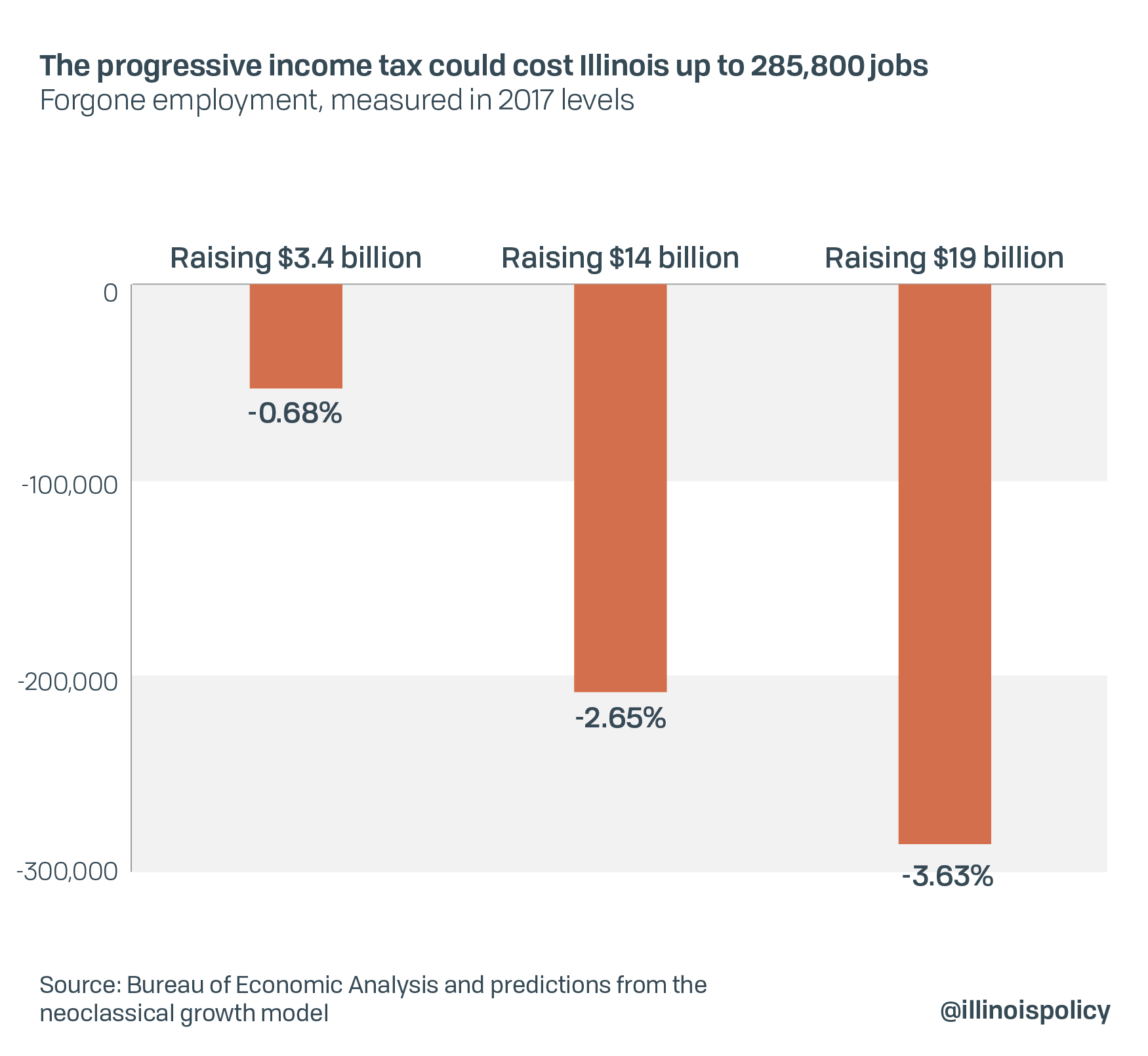
Illinois is already lagging the nation on most economic indicators. The Land of Lincoln only added 71,000 new private-sector jobs in 2018, among the bottom five states in the nation on that key measure. The losses inflicted by a progressive income tax high enough to pay for the governor’s promises would wipe out all of these gains many times over.
This is consistent with what happened in the last state to adopt a progressive income tax. In 1996, Connecticut became the last state to adopt a progressive income tax, and the policy change cost the state’s economy more than $10 billion and 360,000 jobs, ultimately shrinking the labor force by an estimated 362,000 workers.
The tax also didn’t fix any of the state’s budgetary issues. Connecticut has run state budget deficits in 12 of the past 15 years, and is holding more debt per capita than almost any other state. The failure of the progressive income tax has left the typical Connecticut household with an income tax rate increase of more than 13 percent since 1999. At the same time, property tax burdens (property taxes as a share of income) rose by more than 35 percent.
The graduated income tax also didn’t help to combat income inequality: Connecticut had the second highest income inequality (measured by the Gini coefficient) of any state in 2017.
There were 277,000 unemployed Illinoisans in December 2018, and evidence from Connecticut reveals that a progressive income tax will only extend unemployment duration and make it difficult for struggling families to make ends meet.
Efficiency losses: Progressive income taxes are more harmful than flat taxes
Dollar for dollar, progressive income taxes are worse for the economy than flat income taxes. If Pritzker’s goal is to raise revenue while doing the least amount of damage to the economy, a flat tax is a more efficient way to raise revenue. A flat tax that would raise the governor’s desired revenue would inflict less than half the damage that the graduated income tax would.
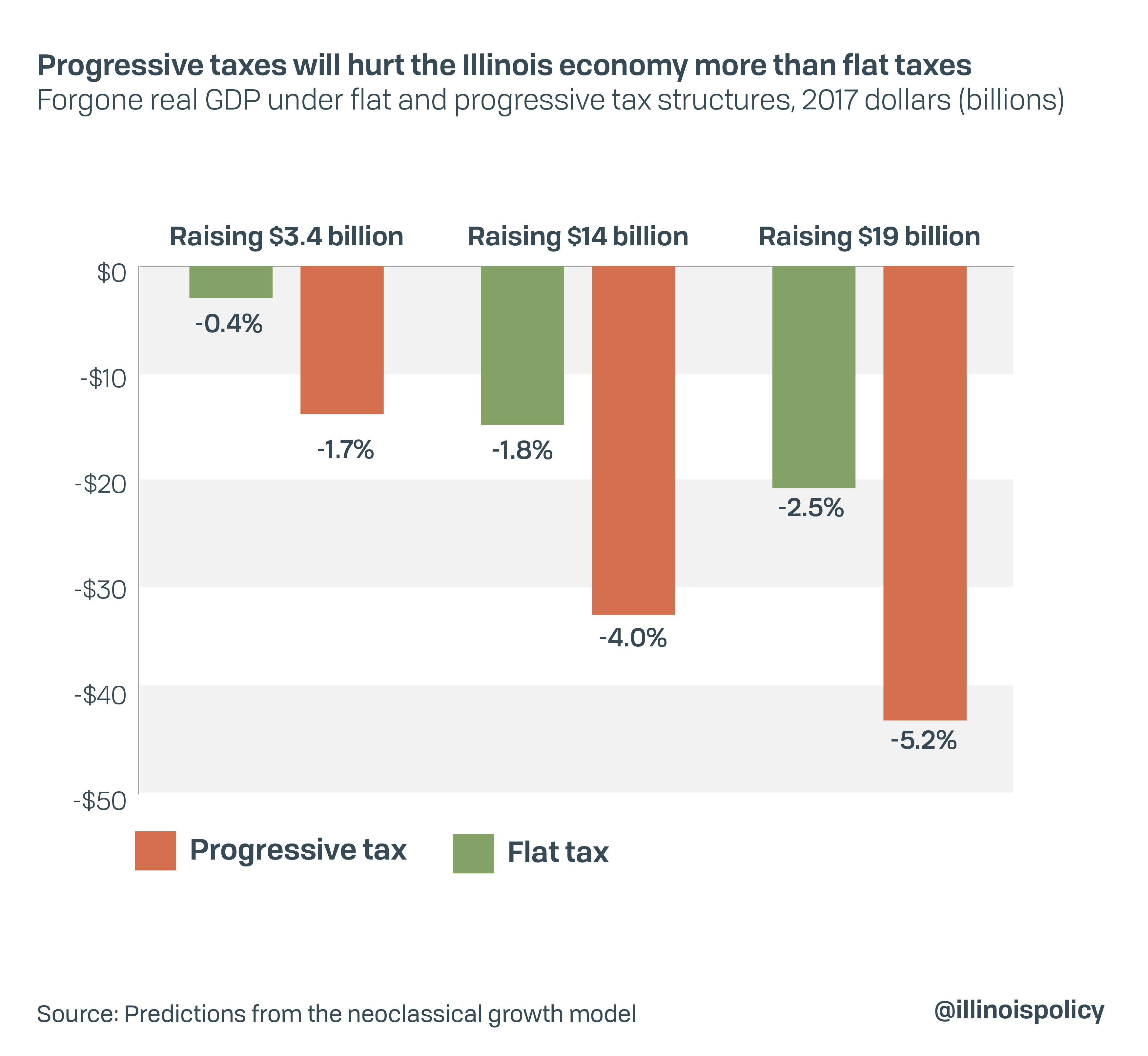
U.S. states provide ample empirical evidence that higher marginal tax rates harm output growth.
Progressive income taxes have a worse effect on the economy because they 1) lower the return on new physical capital investments and 2) deter investment in human capital (education and skills) that boost individuals’ productivity and earning potential. Progressive income taxes also distort the labor supply decision. This is because a progressive income tax system leads to lower net income per hour for someone who decides to work more. When additional output is rewarded with a lower net wage, higher-earning workers exert less effort to create additional wealth.
Investments in human and physical capital have large positive effects on economic growth because investment grows the size of available capital. This makes workers more productive and raises living standards across the board. Meanwhile, if individuals are taxed at a lower rate while less skilled and at a higher rate when they become more skilled, the returns to becoming skilled will be diminished. As a result, skill accumulation and economic growth will be negatively affected.
Progressive income taxes deter investment more than equivalent flat taxes. This is because top earners who have a higher propensity to invest are also more responsive to tax policy changes. The decline in new investments negatively affects labor demand. That means fewer jobs for everyone and a decline in economic growth. Because progressive income taxes have such a negative effect on the economy, they tend to make everyone worse off – even those who may see a tax cut.
While a progressive income tax may offer some residents a lower tax burden, the negative effects of the tax – job losses and decreased productivity from a reduction in all forms of investment – cause incomes adjusted for the cost of living, or real purchasing power, to decline. This leaves everyone worse off than they would be under a flat tax system that raises just as much tax revenue.
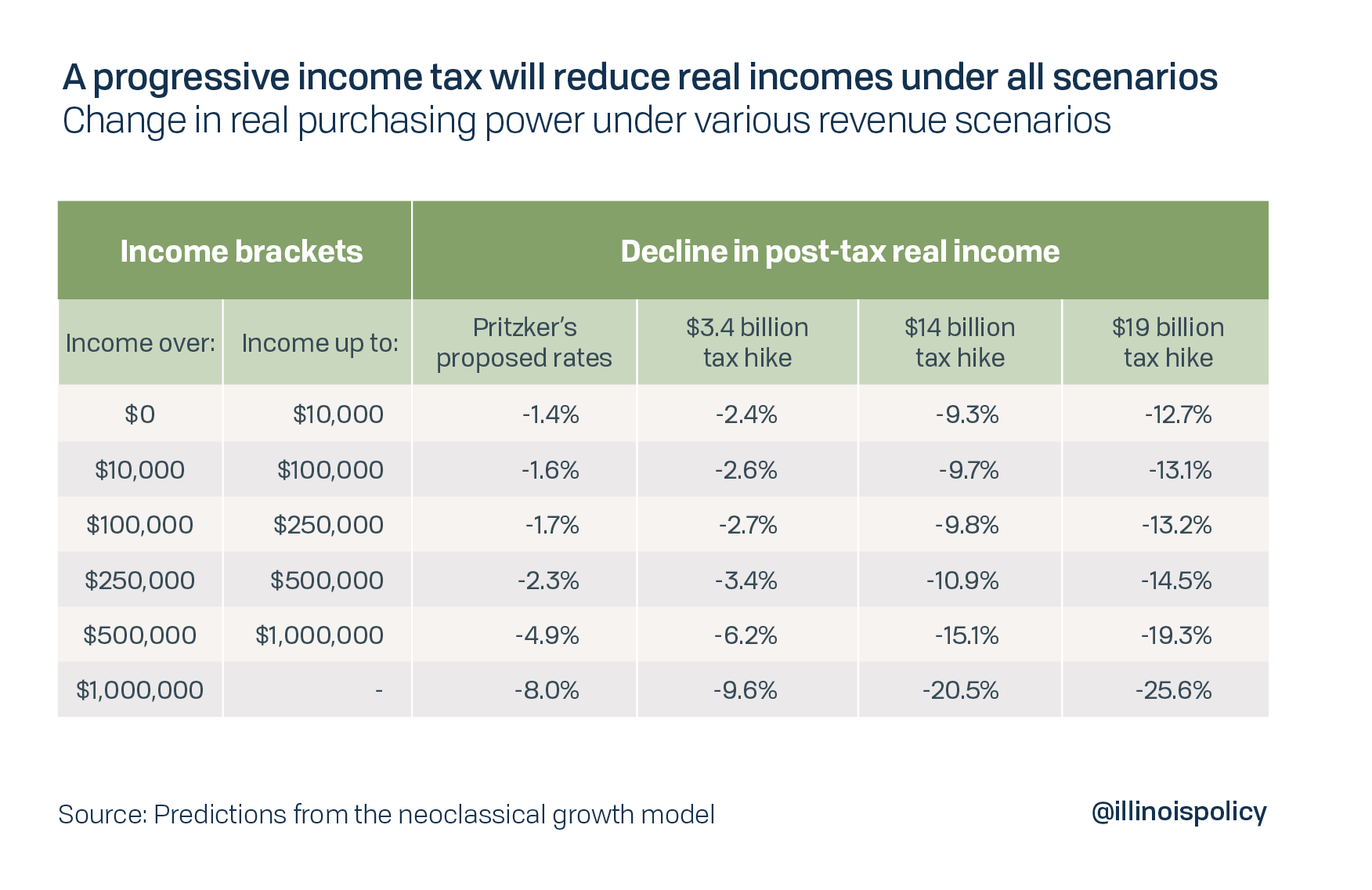
Pritzker’s progressive income tax hike is a bad deal for all Illinoisans. The large negative effects of the tax hike on the economy will lead to a reduction in living standards for everyone, even those who may receive a temporary tax cut. This is why Illinoisans should protect their flat income tax.
The progressive income tax is a poverty trap
The progressive income tax traps individuals at the bottom of the income distribution. This could explain why the last state to adopt a progressive income tax – Connecticut – saw large increases in the state’s poverty rate when the incidence of poverty was falling in most U.S. states.
Higher progressivity in the income tax schedule causes a slowdown in aggregate economic activity and a reduction in living standards for everyone, including those at the bottom of the income distribution.
Even when large swaths of the population get a tax break, disposable income (adjusted for the cost of living) still falls because of a decrease in production that results in lower aggregate output. Individuals at the bottom of the income distribution have less incentive to move up the income ladder because additional income is taxed at a higher rate. The progressive income tax traps individuals at the bottom of the income distribution.
Why a graduated income tax hike will hurt the economy
Since the seminal work of Diamond and Mirrlees (1971), the trade-off between equity and efficiency of progressive tax systems has received considerable attention. On the one hand, progressive taxation is intended to give rise to more equitable allocation of income, but it does so at the cost of distorting the labor supply decision.
By lowering after-tax wages, higher taxes on labor reduce work incentives (also known as the substitution effect). At the same time, a decrease in income from a tax hike can also induce an increase in market activity (also known as the income effect). The net effect on labor supply depends on which effect dominates, the substitution effect or the income effect.
Graduated income taxes aim to transfer benefits to those at the bottom of the income distribution. The result of this policy is a positive income effect for the bottom of the income distribution, which leads to a reduction in paid work hours for lower income individuals. Meanwhile, those at the top of the income distribution have less incentive to expend extra effort to earn a greater income or to grow the capital stock (research and development, purchases of new machinery, or other equipment that improves labor productivity). This results in less income generation and lower living standards for everyone, and demonstrates why marginal tax rates should not increase with earning ability. (Diamond and Mirrlees, 1971; Gruber and Saez, 2002).
This theory is consistent with the bulk of empirical evidence suggesting that higher taxes deter people from actively engaging in the market, causing a reduction in investment and output that lowers living standards.
Conclusion
Pritzker should abandon his plans for a progressive tax hike to finance billions of dollars in new spending. Instead, the governor should look to structurally reform the cost drivers of Illinois’ budget and debt problems: rising costs for pensions and government worker health insurance. The Illinois Policy Institute recently released Budget Solutions 2020, a plan to balance Illinois’ budget immediately, pay off its debt and cut taxes in less than five years.
The most critical single aspect of any good budget plan in Illinois is meaningful pension reform to put the state on a trajectory where pension contributions are significantly lower in the short term but also sufficient to eliminate the state’s unfunded liability more quickly than planned under current law. Standard & Poor’s Global Ratings recently confirmed that Illinois cannot avoid a junk credit rating without a “practical reduction in liabilities,” which can only be achieved through pension reform.
Pritzker should push for an amendment to the state constitution that allows for slower growth in future benefits, while protecting all benefits earned to date. HJRCA 21 would do just that.
By adopting structural spending reforms, Pritzker can achieve his goals of investing in core government services such as education, social services and public safety without more economically harmful tax hikes.
Endnotes
- “Full Text: Pritzker’s Budget Address,” Crain’s Chicago Business, February 20, 2019.
- Adam Schuster, Orphe Divounguy, and Bryce Hill, “Pritzker Price Tag: Candidate’s Spending Promises Require Doubling State Income Tax,” Illinois Policy Institute, Fall 2018.
- State of Illinois, Fiscal Year 2020 Proposed Budget.
- Cost estimates based on public statements as reflected in “Pritzker Price Tag.” Updated to reflect governor’s Fiscal Year 2020 Proposed Budget and Illinois State Board of Education, Fiscal Year 2020 Proposed Budget. See Appendix A for a detailed breakdown of Pritzker’s spending promises.
- A progressive income tax requires a constitutional amendment, which would need to be approved by voters in the November 2020 general election at the earliest. Therefore, the first budget year for which Pritzker could bank a full year of revenue from the progressive tax hike would be fiscal year 2022.